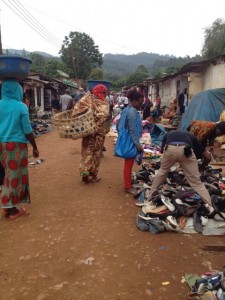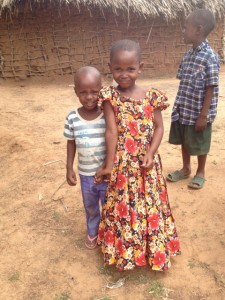by Paddy Miller
The Tanzanian trip had two parts, cycling the Usambara Mountains and climbing Mount Kilimanjaro. Nine of the twelve participants then took advantage of being in Africa by going on safari.
The North-eastern part of Tanzania is beautiful country, with amazing contrasts from steep mountains to barren plains, rain forests to arid flatlands, and bustling cities to small remote villages. The one constant is the people, friendly, helpful, happy, and welcoming. Many expressed surprise that we would be attempting to tour their country by bicycle. Indeed, one farmer asked, “Why would you come here from Canada to bicycle?” At times after a day of rutted roads, “with potholes the size of a pig” (Carole LaFlamme), and sand and rocks on the road, I too wondered why we had chosen this mode of seeing the country. The reasons of course are first, the route took us into remote areas, dotted with small villages with few or no tourists; secondly, we were able to see life as it is really lived in rural Tanzania; and thirdly, we were able to meet and converse with the likes of the farmer above.
The trip was challenging. The first challenge was to prepare and pack for both cycling and hiking, for temperatures ranging from above 40ᴼC on the plains to well below freezing at the top of Mt Kilimanjaro, as well as rain gear for both activities. What to bring was the next challenge. Fortunately, Tour Coordinator Max McClanahan, provided us with a two page list of clothing and equipment required. The third challenge was to figure out how to get all the articles into bags that did not render us overweight on the airport scales.
A trip to a travel clinic was essential. Several prescriptions later we were outfitted to cope with malaria, travellers’ diarrhea, altitude sickness and rabid dogs. As it turned out we saw very few mosquitos and hardly any dogs; the latter, by the way, were as friendly as their owners.
The cycling portion of the tour, run by a Tanzanian company, The Friends of Usumbara Society, started in Zanzibar’s historic Stonetown. A walking tour, led by a very knowable guide, ended at the Two Tables Restaurant run by a Muslim family. We ascended a steep flight of stairs into their living room where the host’s twenty-four grandchildren were seated in a circle patiently and quietly waiting for their lunch, which arrived about the same time as we began a delicious seven course meal.
The cycling began in earnest on the mainland five hours northwest of Dar es Salaam in the foothills of the Usambara Mountains. It was beautiful, breath-taking and somewhat worrisome as we looked across valleys at the winding, upward-trending roads that lay ahead. Who knew these wonderfully friendly folk could so welcome cycling seniors to make use of their rutted, bumpy, sandy, rock-strewn roads. How cruel. In addition, I was always tickled by the speed bumps at the entrance and exits to the villages. These  oversized, hippo-sized bumps were no deterrent to speeding vehicles and motor scooters, but were certainly annoying for us. At our frequent village, ginger-soda induced stops, Max and Valerie’s tandem garnered much attention.
oversized, hippo-sized bumps were no deterrent to speeding vehicles and motor scooters, but were certainly annoying for us. At our frequent village, ginger-soda induced stops, Max and Valerie’s tandem garnered much attention.
While most people had a tumble off their bikes sometime during the two week ride, no one was seriously injured. The only person who had flatted, and it was frequent, was one guide riding an old mountain bike with bald tires. Even an attempt to “green-slime” his tires failed; his new slimed tires would not fit the rim. The guides, Easa and Omari, were most patient, pleasant, helpful, and lastly, all knowing when it came to the local resources, such as motorcycles with trailers. A huge help, when at 40ᴼC one-half of us bailed the bikes. Stewart (his real name is Stelwart), our cook, provided nutritious and inventive meals with lots of fresh vegetables and fruit. He was a group favourite. On one particularly hot 45ᴼC day he stopped, bought and cut up iced cold watermelon; a perfect snack for our parched group. Ross’s favourite of Stewart’s innovative dishes, was popcorn and peanuts for breakfast.
Lodging ranged from modest road-side motels to a convent where hot water was brought to us in buckets, up three flights of stairs, by novice nuns. Electricity in most accommodations worked sporadically, thus hot water was a rarity. One beautiful evening, mid-Usambaro Range, the lodging’s noisy gas-powered generator huffed and puffed right below our bedroom window. The Mumbo Eco Lodge had breath-taking views of the plains hundreds of meters below. The Lodges perch also gave us a glimpse of our next day’s heavily rutted road, which wound down and down and down to the Masai dwellers and their Acacia-riddled plains; Max’s flat alley.
 A highlight for most of us was the children. They lined the side of the road, chasing after us, calling Jambo Jambo (hello), and bursting into huge giggles after we passed. Who were these strange white folk in their peculiar biking gear? There were no toys in evidence other than soccer balls made out of straw and duct tape, or old wheel rims propelled by sticks, yet their smiling faces and the enthusiasm was inspiring.
A highlight for most of us was the children. They lined the side of the road, chasing after us, calling Jambo Jambo (hello), and bursting into huge giggles after we passed. Who were these strange white folk in their peculiar biking gear? There were no toys in evidence other than soccer balls made out of straw and duct tape, or old wheel rims propelled by sticks, yet their smiling faces and the enthusiasm was inspiring.
The morning after finishing this arduous bike ride, can you believe it? we were transported to the national park gate to begin the hike up Mount Kilimanjaro. “No rest for the wicked.” We encountered a large parking lot filled with buses carrying other tourists who were starting the trek. Our group of nine people had four guides, two cooks and twenty-five porters. Multiply that by all the other busloads and you can conclude this will not be a wilderness experience.
The first day’s climb took us through a rain forest (and indeed it did rain), and then the alpine and subalpine areas; the vegetation changing from lush to barren the higher we walked. Bush2City, our tour company was formed five years ago by three university buddies who completed their degrees in tourism by working as porters. They created and exemplary trek; well organized, the staff knowledgeable, helpful and happy. The latter behaviour may have been the empathetic employers; the egalitarian and transparent way the tips were divvied provides an example. We gave our contributions to the tour leader who counted it in front of representatives of the porters and cook staff. The money was then presented publicly to each staff person. Some of us left gear (rain jackets, down vests, sandals, etc.) which were distributed to the staff through a draw system. Later we sang and danced with the Porters. Fun and tear-rendering it was.
Each mountain day began with breakfast in the dining tent where conversation centred around thin mattresses, flapping tents, cold nights and our wellness. Nurses Denise and Lucas were consulted re sore toes, blisters, upset tummies and altitude sickness.
The final ascent began at midnight at 4 600 meters. We followed Keddy (the lead guide) in single file, all participants wearing head lamps and moving “poley poley” (Swahili for slow). Rinaldo, the sweep, sang soothing Swahili songs as we puffed our way upward. The tour leaders howled at the moon, at the sun, and to each other. At 5 700 meters, we were given hot sweet tea. What a treat it was. It powered us past glaciers to the Uhuru summit (Swahili for freedom) at 5 895 meters (19,000 plus feet). We hugged. We snapped photos. And after only minutes of revelry we began our descent.
Seven of our nine starting climbers? – mmm cyclists? – summited Kilimanjaro; pretty good for a bunch of seniors, when the average success rate for the six-day route is less than 40%. Summiting Mt Kilimanjaro was a definite big-time highlight; a bucket list achievement for sure, and provided a wonderful sense of accomplishment.
Cycling the Usambara, hiking Kilimanjaro, meeting the friendly Tanzanian people, and viewing spectacular scenery provided a “trip of a lifetime” for most of us. Thank you Max for having the foresight and might I say, creative spirit to offer such an adventurous journey to we seniors; and well organized it was.
For more details on the tour, “2016 Tanzania – Surf to Summit”, please see the Tanzania Blog!